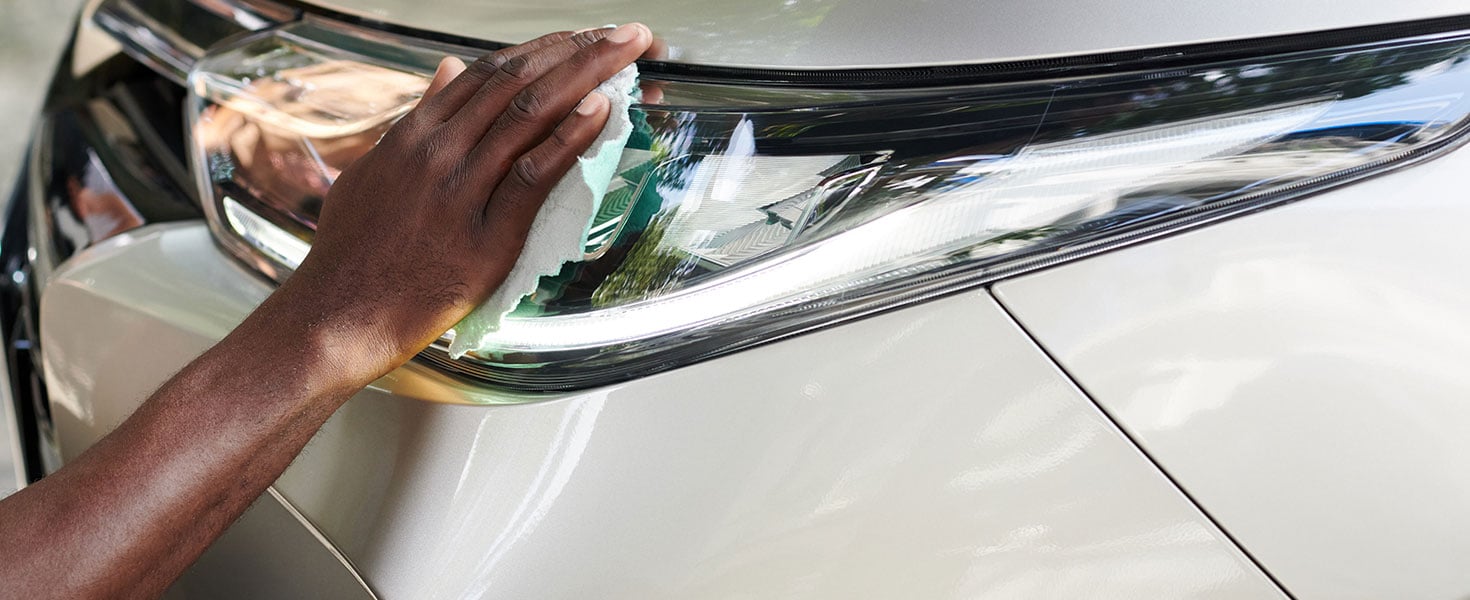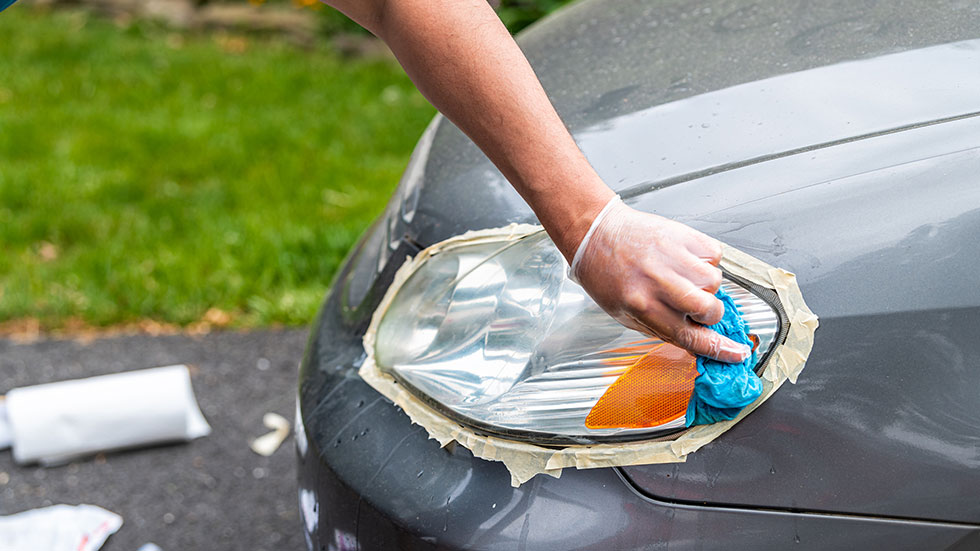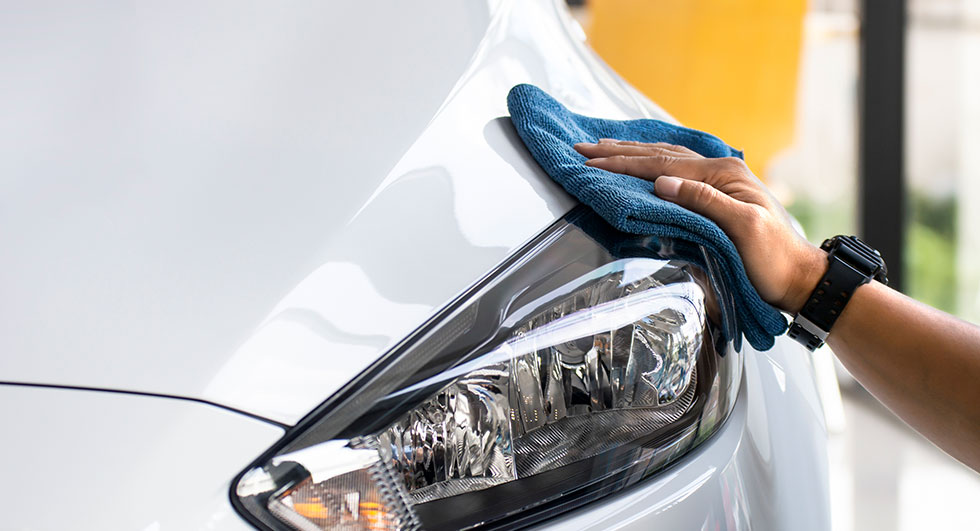Do Headlight Cleaning Hacks Actually Work
From toothpaste to baking soda to lemons, here are the best—and worst—hacks for how to clean hazy headlights


In today's connected world, everyone is an expert in the eyes of the internet. From Instagram and YouTube influencers to TikTok celebrities, there’s no shortage of folks eager to show you the quickest way to clean a catfish, the best way to sneak candy into a movie theater, or how to MacGuyver together an air conditioner with an oscillating fan and bottles of water. Whatever problem you need to solve, task you need to accomplish, or subject you need to learn the internet is at the ready to help you get to the bottom of it.
When it comes to DIY tricks and hacks for automobiles, there is also no shortage of internet experts promising to save you time, money, and elbow grease to help you keep your vehicle running and looking like new. One popular topic is how to clean headlights. It is common for older vehicles to experience dimmed or yellowed headlights, so there are plenty of ideas floating around the interwebs on quick fixes for how to clean cloudy headlights. But are any worth your time, and how well do they work?
To help you cut through the clutter, we share the best—and worst—hacks for cleaning headlights and explain what causes foggy headlights in the first place.

What causes yellow and foggy headlights?
Over time, as a car is exposed to the UV rays of the sun, the elements, and debris kicked up from the road, its headlights may begin to yellow or become foggy. Because most headlight lenses are made of acrylic, they oxidize in the sunlight, becoming yellow and developing microscopic cracks. These cracks, in turn, can collect more dirt and debris, further reducing the headlight's ability to shine light clearly, no matter how many visits to the car wash you make to try to clean them.
Some of the best DIY headlight cleaning tips
If you’re looking for hacks and tricks on how to clean hazy headlights, not all of them work well or are even safe to try. Below are some quick headlight cleaning solutions that are among the safest methods to clean headlights.
- Toothpaste: Can toothpaste clean headlights? Absolutely! In fact, most regular toothpastes contain enough abrasive elements to scuff away the yellow film that develops on old headlights. They are also gentle enough not to scratch the plastic coating. You can also use baking-soda-based toothpaste for extra abrasion and cleaning power. Just take care that you do not leave any on the surrounding bodywork or paint to avoid discoloration or damage.
- Baking soda: There's a reason this common household substance is used to clean everything, from carpets to pots and pans: because it works! You can mix baking soda and white vinegar paste using a two-to-one ratio of vinegar to baking soda. Once mixed, use a clean microfiber cloth or soft-bristled toothbrush to apply the mixture to your headlight, moving in a circular motion. Once you’ve finished, rinse the lamp with warm water. Repeat the process until you’ve achieved the desired cleanliness.
- Lemon: The acidic properties of lemon juice can help clear away dirt and oxidization on headlights. You can either apply lemon juice to a microfiber towel and use it to wipe away dirt or add a little baking soda to a lemon half and rub it directly on the headlamp itself. Be careful using the second method as lemon juice left to dry on bodywork or paint can damage it. Always rinse and use a clean microfiber cloth after cleaning. Repeat the process until you have achieved the cleanliness you want.
- Headlight cleaning kit: Of course, one of the most thorough ways to clean and restore your headlights is to purchase a purpose-built headlight kit. These usually include fine-grit sanding pads, a clarifying compound, cleaner, and lens wipes. Not only are these kits cost effective, but they are easy to use and do a fantastic job of clearing up cloudy headlights.

Some of the worst headlight restoration methods
Avoid all the following "hacks" if you are trying to figure out how to clean hazy headlights. While some may technically work, the risk of damaging your headlight or vehicle bodywork in the process means they are not worth it.
- Bug spray: While there may be some immediate clearing of the lens when using bug spray or mosquito repellent to clean headlights, they also contain chemicals that can melt or destroy plastic. You should avoid this "hack" as well as spraying any of these chemicals on or near your vehicle.
- Acetone: While it may technically clean your headlight, this highly abrasive method will do more damage than good. It is extremely dangerous to use acetone near any painted bodywork or plastic as it will damage these things on contact.
- Clear coat paint: While this hack might be a temporary fix, it's time-consuming, and its efficacy isn't totally certain. Some vehicle owners sand away oxidation to clear it and then use a fine application of clear coat paint to seal in the clear finish. The problem is that, over time, this clear coat will also oxidize and crack. Although these products are made for automotive applications, they were not designed to cover headlights and could wind up making your visibility worse.
- Home cleaners: While there are many home cleaning solvents like Bar Keepers Friend, Murphy's Oil Soap, Windex, and oven cleaners that can be used to clean headlights, many of them also damage paint and colored plastic after repeated use. It’s always best to do what you can to preserve your vehicle's paint and shine as much as possible, so heed the cautions if you choose to use any household cleaner to clear headlights.

How do you know how long car headlights will last?
Most light bulbs, including headlights, will have a lifespan rating in hours. Due in part to the range in types of bulbs used for headlights, the lifespan will vary. For stock headlights (the bulbs included with the vehicle when it was made), the proper illumination typically last between 500 and 1,000 hours. For exact specifications, consult your owner’s manual. Premium bulbs like High Intensity Discharge (HID) last longer with lifespans between 2,000 and 3,000 hours. Light Emitting Diode (LED) bulbs last the longest, with lifespans reaching up to 50,000 hours or longer. Proceed with care with LED bulbs, however, as they are not always legal. When in doubt, be sure to check the local traffic laws in your area before having new headlights installed.
Where can I get my headlight fixed?
If you decide your headlights are just too foggy or you’ve tried to clean your hazy headlights using one of the methods above with much success, the good news is that finding a place where you can get your headlight changed or adjusted is relatively easy. A headlight replacement is a relatively minor repair. All AAA Approved Auto Repair or AAA Car Care centers can help you remedy foggy headlights. Also, most staff at auto parts stores will be able to help you find a good headlight replacement at an affordable price.
When it comes to foggy headlights, one thing is clear: As many ways as there are to clean yellowed headlights, there are also just as many that you should avoid completely. Stick with purpose-built products for cleaning headlights or seek out a professional auto repair shop near you if you want to achieve the best results.
